Heritage: The Rise Of FMX
Way back in 2010, in the very first issue of Transmoto, we ran what many thought was a landmark feature article about the history of freestyle motocross in Australia – billed on the cover as, “The Story of FMX in Oz – the birth & building of an aerial empire”. And with the recent announcement that the Crusty Demons live shows are back in Oz after a long hiatus, we thought it’d be a good time to revisit that piece. Enjoy…
The emergence of freestyle motocross in Australasia was like a wombat giving birth to a kangaroo – it was a gangly, awkward beast, plagued by impossibility. And though it could jump, it didn’t really know which direction to head at first. The sport’s actual birth date is a much-debated point. Opinion oscillates between the Gold Coast Planet X Games in 1998, the Melbourne Planet X Games in 2000, the release of Crusty Demons of Dirt in 1995, and the first No-Hander ever performed by Craig Dack in the middle of a supercross race in the late ’80s. But in reality, the timing of its conception is a moot point. What’s not debatable is FMX’s incredibly rapid growth Downunder, and that Australian and Kiwi riders are now recognised as among the world’s best.
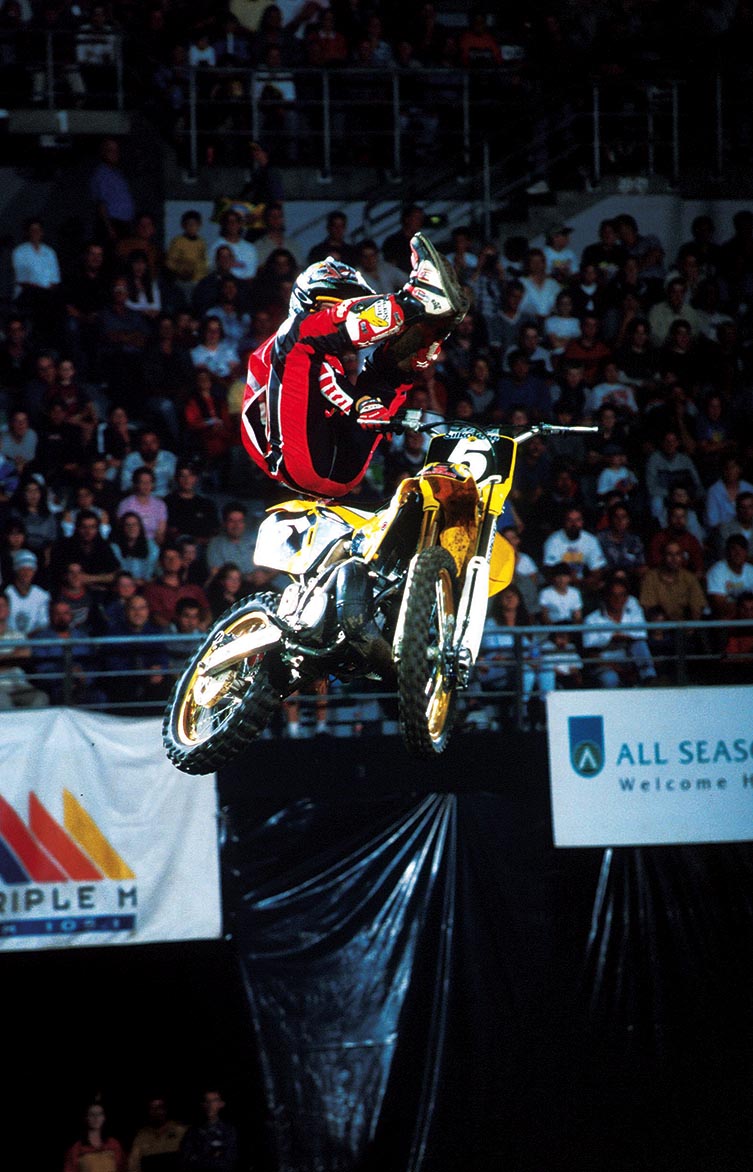
The late Jono Porter invented the Port Air while play-riding, wearing only shorts, T-shirt and a helmet.
![]()
IN THE BEGINNING…
![]()
Jeremy McGrath brought the Nac Nac to the Orlando Supercross in 1994 and it trumped any trick that went before it, although photos of “Flash” Gordon Ward doing a Heelclicker at Perris Raceway in 1985 suggest freestyle had even deeper roots in California. In Australia, Newcastle riders Danny Ham and Ben Jones were doing Heelclickers on their 80s around 1992. “I brought the Nac Nac, Can to Double Can, Saran Wrap and Straight Superman to Australian audiences,” Ham offers. “Ben Jones made the Nac Nac a massive deal and really stepped up the Whip.” At the time, a rider named Blake Williams was just a punk trying to get his 80 across the line in first place at a Sunday moto, but he recalls the first formal events that unwittingly sparked a movement. “It really all started when the Supercross Masters had the Expression Sessions and the racers were going out and huckin’ tricks off the triples,” Bilko explains.
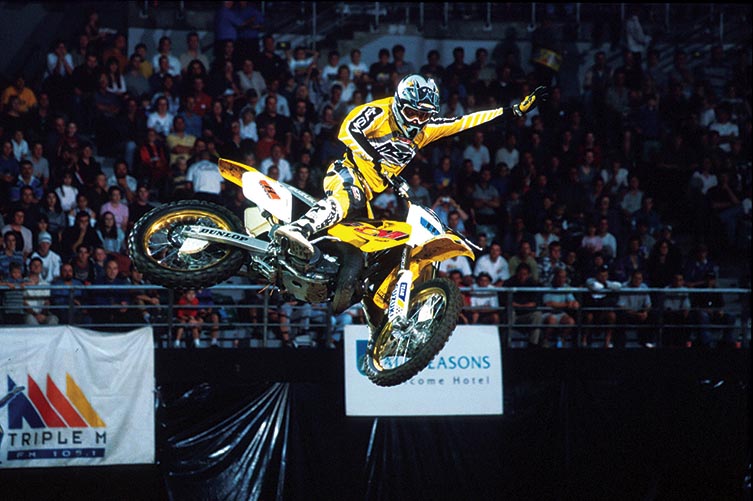
Danny Ham helped bring FMX to SX crowds in the late ’90s.
SX Masters promoter, Spokes Promotions, claimed to have pioneered FMX “back in 1987”, but it was Spokes’ Jumpmania events much later (held the day after a supercross round), which really gave the sport a shot in the arm. In 1995, Stu Gundry, a motocross racer since his early years, knew he’d witnessed something special when he watched the premiere of a new film called Crusty Demons of Dirt in the USA. “I brought boxes of Crusty videos back to Australia with me and started selling them,” recalls Gundry, whose business – Platypus Distribution – has fuelled Australia’s FMX fire since the very beginning. The new approach to playriding had an instant impact among Australian motocrossers.
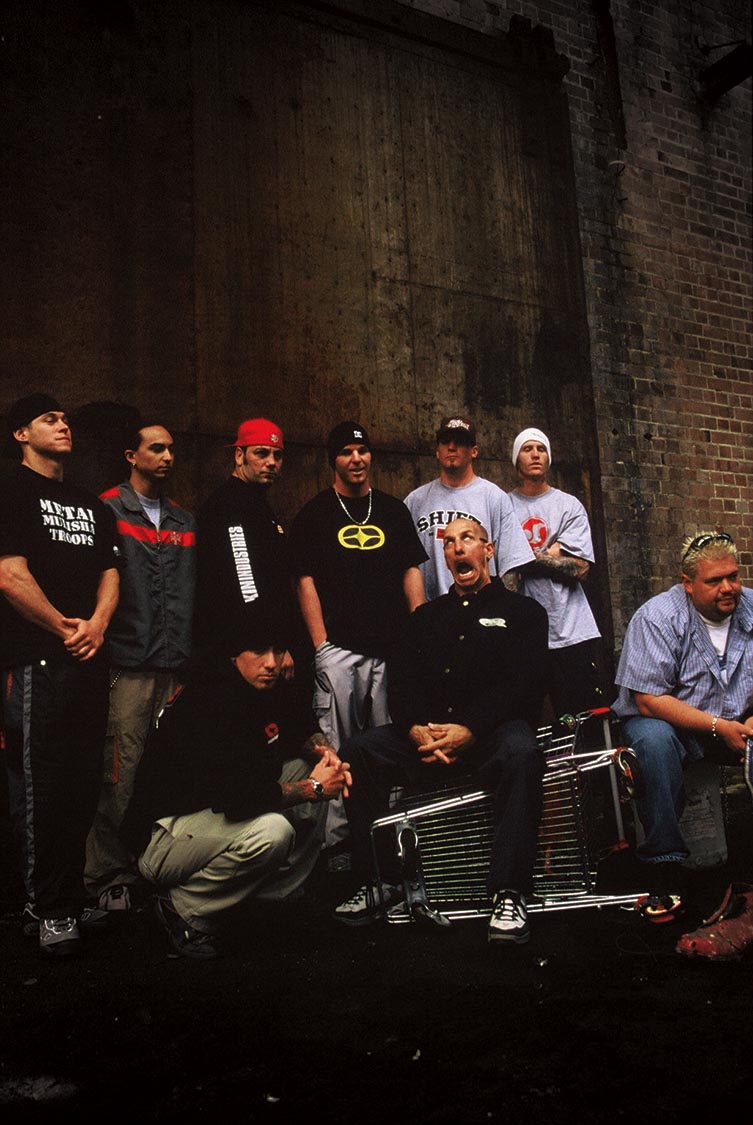
The original Crusty Demons of Dirt posse to tour Australia.
In early 1998, up and coming motocross mates Adam Cini and Robbie Marshall started to do tricks in between training motos in Queensland. “We were riding at my house and started mucking around trying tricks. Next thing, I got a phone call from the guys wanting me to go to the first Planet X Games on the Gold Coast. I was only 14 at the time,” Marshall explains.
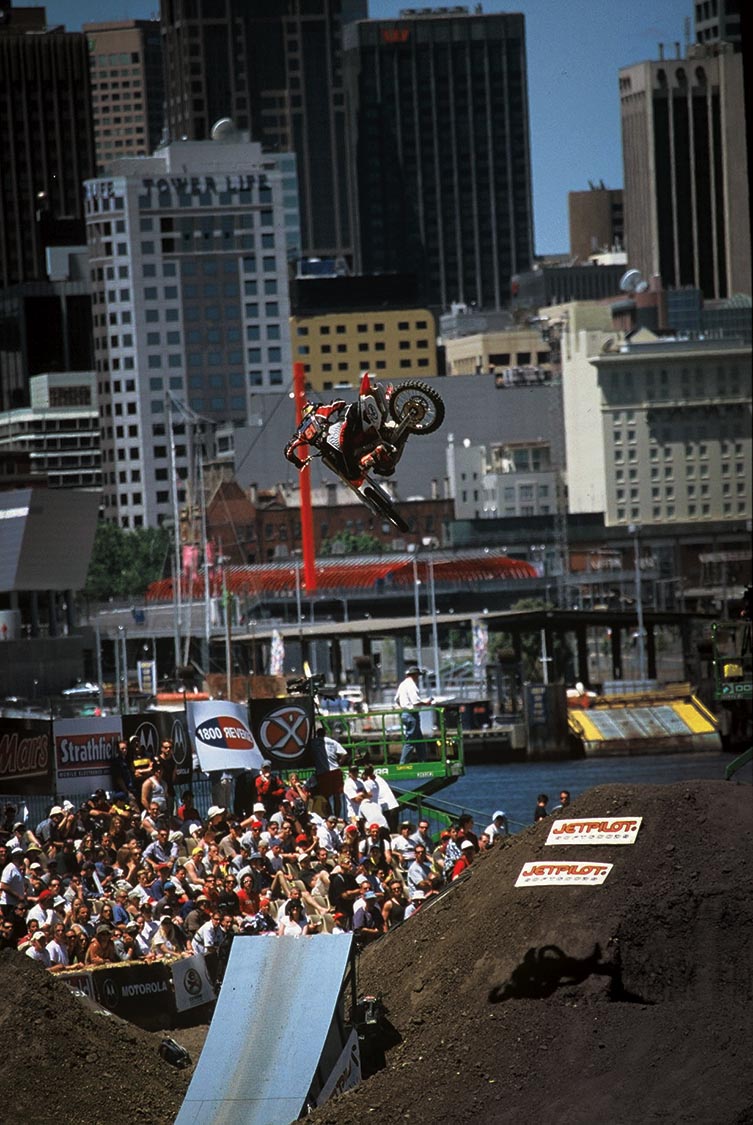
Robbie Marshall whippin’ it at 16 years of age at the Melbourne X Games – the first time Aussies had a chance to take on the world.
The Gold Coast Planet X Games was the first FMX competition to be held in Australia. It attracted the late Andrew McFarlane, Takeshi Katsuya and Robbie Marshall, but was won by a KTM-mounted Troy Carroll. “It was all about the party back then,” concedes Carroll. The ’98 Gold Coast event vindicated the fledgeling sport in Australia and showed that we had the riders to impress mainstream crowds. That was confirmed when promoter Wayne McNabb staged the first ever Crusty show in Perth a year later. McNabb had toured AMA motocross races, the X Games, met Brian Deegan and a handful of other key players in the States. These experiences spawned the idea to hold an Australia vs USA supercross event. “Freestyle then took off and it was decided we’d do an FMX demo instead,” recalls McNabb. “It was called the 96fm Jump Spectacular. But me and a mate came up with the name All Crusted Out, which it became tagged in the videos and ultimately known as.
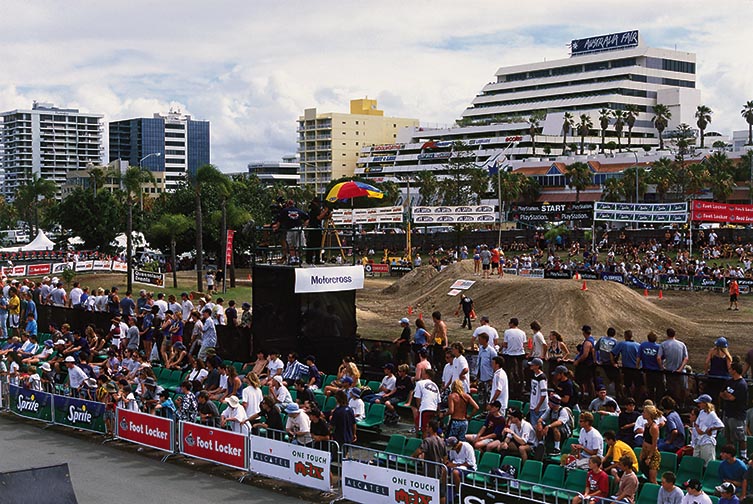
The Gold Coast Planet X Games in 1998 was judged by Seth Enslow.
“I told the cops I thought 5000 to 7500 people would attend a motocross event at night. They laughed and said they’d send a squad car down for a look on the night. We sold 10,000 tickets, but more like 15,000 showed up or gate-crashed. I was in the middle of the venue thinking, ‘Oh shit, what have I done?’ I could just feel so much energy. I knew something was going to happen and then five minutes later, Mike Metzger goes, ‘Who wants my helmet?’ “About 500 people storm the field and ultimately shut the show down 15 minutes early. Within the hour, there were 25 squad cars and a helicopter attending what the media called ‘a riot’. It was a great way to end the show. Hart, Deegan, Linkogle, Metzger, Faisst, Adoptante, Seth and Micky Dymond all appeared at the first shows. It was Australia’s first ever standalone freestyle event and the first time all the riders had been together for a big show.”
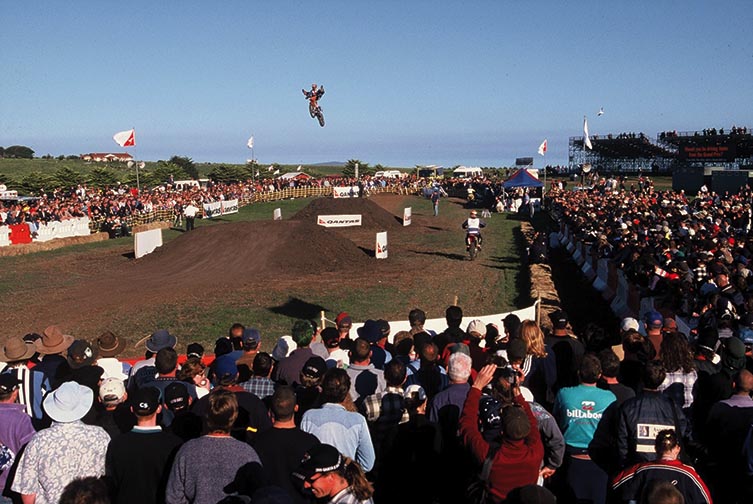
The first FMX demo at the Phillip Island MotoGP – 1999.
![]()
FMX MEDIA
![]()
Towards the end of 1999, a bloke called Michael Gilbert knocked on publisher Peter Morrison’s door at Morrison Media. He had an idea for a new motocross magazine with the lifestyle dial turned right up. It would become Freerider MX. “It was a great fit with our other action sports titles and just seemed a natural progression,” says Peter Morrison. Gilbert produced one magazine in 1999 before Aussie moto journalist Andrew Clubb took over the reins, but it was Grant “Goba” O’Brien who distilled the freestyle voice from the chain chatter when he got involved a few issues later. Current editor Simon Makker recalls the shift as the magazine moved away from race and its focus became freestyle: “The riders and contributors really took ownership of the magazine and the relationship between the two groups saw it continually grow,” he told Transmoto. But Freerider MX wasn’t the only media initiative to fuel the sport in Australia. “Homegrown Maniacs was the brainchild of Leith Holtzman – a guy who has turned his pockets inside-out numerous times to push FMX forward in Australia,” asserts FMX commentator, Justin Bush, who still works with Holtzy on his Homegrown Maniacs TV show.
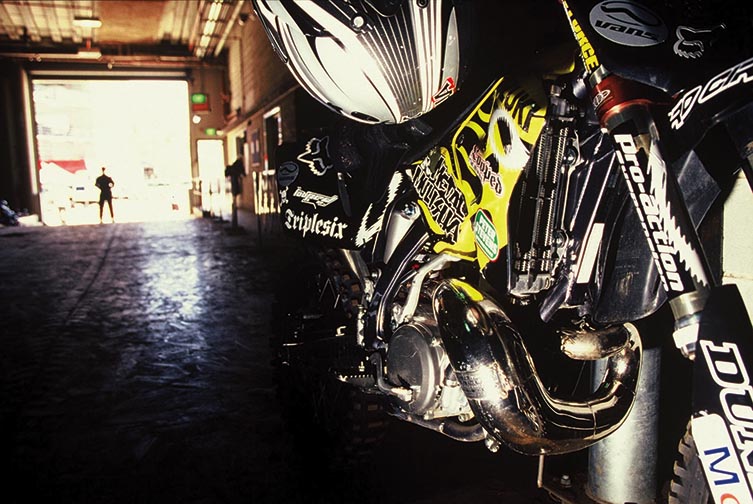
“In the early days, Holtzy would create road trips and film up-and-comers ripping in their own backyard for the Homegrown Maniacs FMX movies.” A defining moment for Holtzy came after calling Platypus Distribution’s Stu Gundry before embarking a road trip to film Homegrown Maniacs 1. “Stu had some phone numbers of unknown kids who were chasing him for sponsorship. He had no idea how good they were because no one knew anything at that stage,” begins Holtzy. “In that one big road trip, I discovered most of that first generation of stars. I filmed Luke Urek and John Flint in Victoria, then onto NSW with Dayne Kinnaird, Noel Cotter, Rhys Dulieu and the Hall Brothers all for the first time ever. Then I finished up with the only ‘known’ freestyle riders of the time: Troy Carroll and his brother Quentin. Throw in Josh Maley and James Dance in my home state and those names filled a lot of the early magazines. It was a special time and to this day I’m amazed at what I was able to achieve on almost no money at all. I spent a lot of time hitching, catching buses and sleeping on floors,” he laughs.
![]()
NEW ERA RIDERS
![]()
The 2000 Planet X Games, held at Docklands in Melbourne, was the first time Australian riders were able to pit their skills against the world’s best. The result “catapulted the Aussie riders into the spotlight”, says Goba. “It really showed the gutsy spirit of emerging Aussie riders Luke Urek, Dayne Kinnaird, Dan Hall, Robbie Marshall, Leigh Harriman, Shaun Richardson, Johnny Flint and Noel Cotter, plus Kiwi Rhys Dulieu.” In windy conditions, it was Urek who beat “Mad” Mike Jones, Jeremy Carter, Busty Wolter and Carey Hart, who was fresh from his legendary Backflip attempt at Gravity Games in the US. Urek’s win began a new chapter in the Australian FMX story – the top riders had a sniff of the world stage.
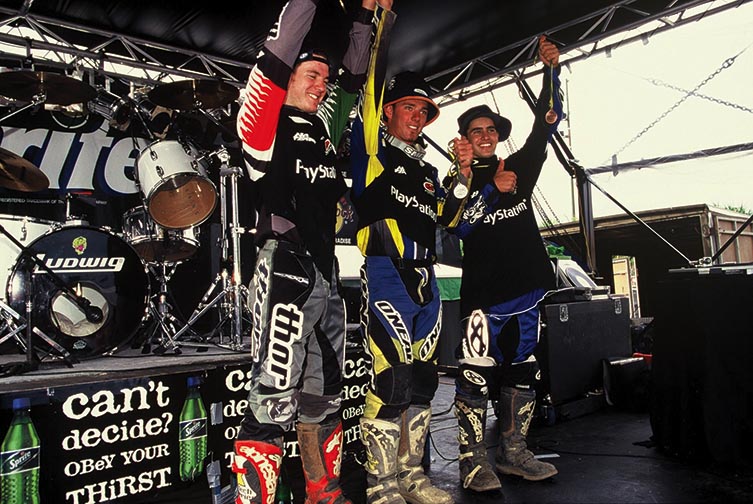
’98 Planet X: Troy Carroll wins Australia’s first FMX competition with Double Can Cans and Shin Scrapers.
“The sport really started to build momentum in Australia from the year 2000 with the likes of Jono Porter, LeighHarriman and Shaun Richardson flying the flag for the Queenslanders and all having their own compounds. The Hall bros’ – Dan and Mick – property in Coffs Harbour was a popular destination for many of the top riders, including Dayne Kinnaird. Several stories, photo shoots, underground events and parties took place there and it was an integral part of the early FMX scene in Oz,” explains Goba. “Moving south, the Cole bros – Luke and Matt – also set up a compound in the early days and a decade later it’s still being used. Noel Cotter’s ‘Shagga’s Compound’ was set up on the southern side of Sydney in the middle of an industrial estate. Luke Urek and John Flint were the guys in Victoria rocking the scene, and over in the west Josh Maley was pivotal in getting the WA FMX scene cranking. From Kiwiland, Rhys ‘The Barhop King’ Dulieu was one of the first to emerge.”
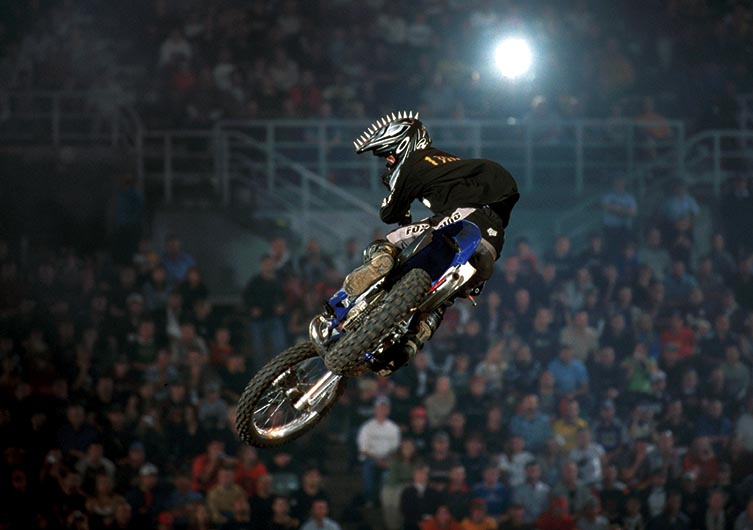
Luke Urek’s win against the world’s best at the 2000 X Games in Melbourne helped put Aussie FMXers on the map.
Simon Makker believes these friendly rivalries accelerated the sport’s progression: “It was mates trying to out-do mates,” he explains. “The competitive streak of the riders made them want to try and learn – or invent – the latest, greatest tricks before their mates.” It was a time when creativity was rewarded. Danny Ham remembered watching Jono Porter – “one of the most talented riders Australia ever saw” – invent the Port Air: “He invented a move while we were out playriding in only shorts, a T-shirt and a helmet one day: the Port Air. The only other person I have seen do this move is Mike Metzger.”
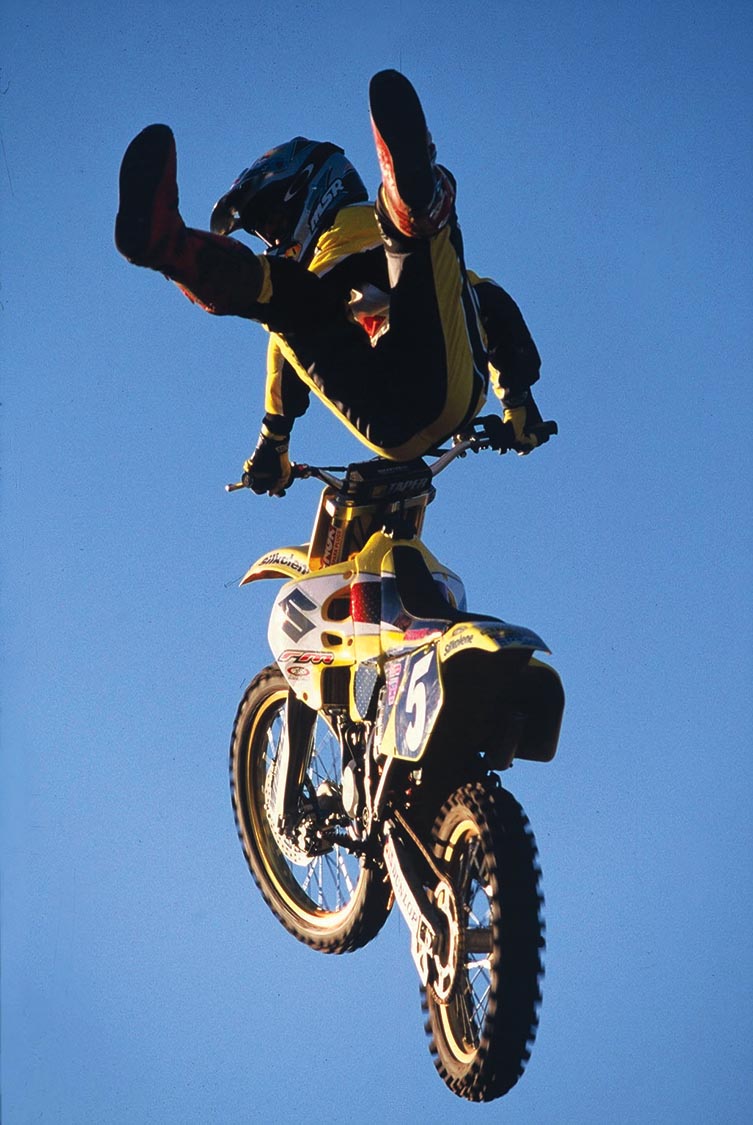
Jono Porter’s contorted Double-Cans wowed MotoGP crowds in ’99.
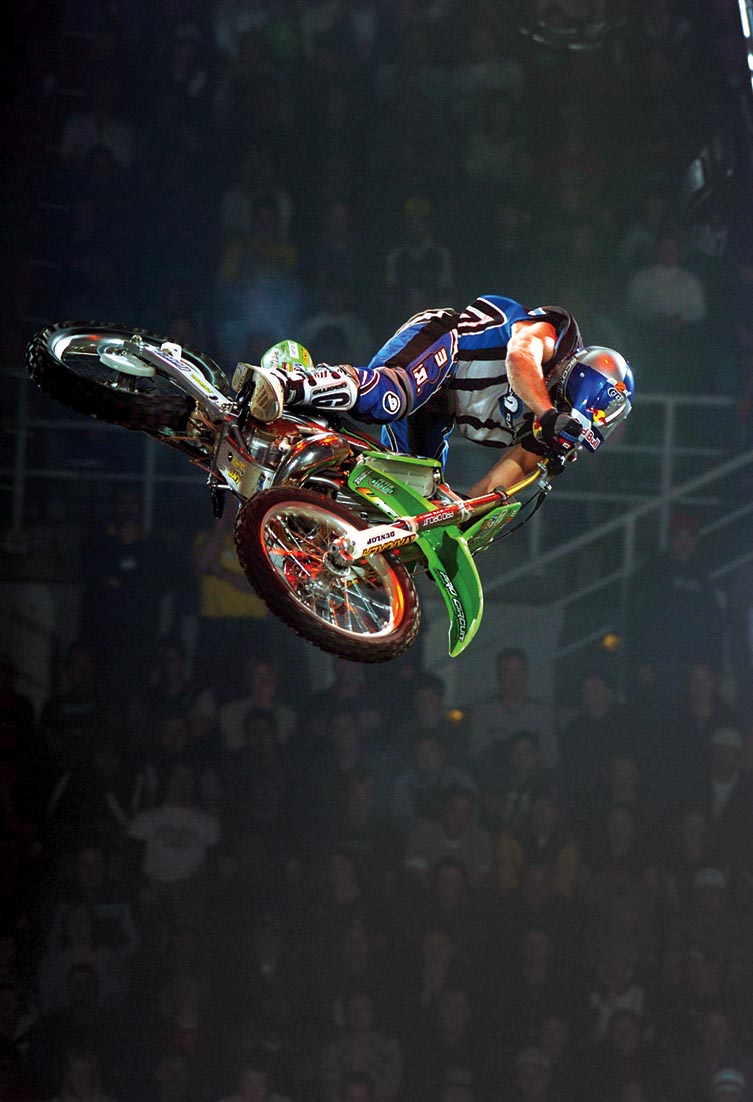
Mad Mike Jones on tour with the Crusty Demons in 2000.
Professionalism was starting to creep into the sport and in 2001 a guy called Gary Reid threw in his day job and launched his ShowTime FMX shows. With a background in waterski shows at Sea World, Reid was one of the first to showcase the sport and its incredible athletes to the masses. ShowTime FMX built Australia’s first portable FMX ramp set-up and is now Australia’s longest-running FMX show. While the athleticism of the sport was progressing, the cultural side of the sport was on a wild ride of its own.
![]()
A CULTURAL SHIFT
![]()
“My best memories are from the early days – before the sport became full of wankers,” laughs Stu Gundry. “The mid- to late-’90s and early 2000s – that was a cool time when we used to rock out to nightclubs with 3000 people and do video premieres and fashion parades and we had semi-naked chicks on stage cutting sick and everyone just getting fully loose and down with the party.” The party ethos spread like wildfire through FMX. It was contagious and mostly out of control. It was ignited by the rock stars of Crusty, but fuelled by the Australian public’s latent desire for something fresh, alternative, edgy and totally off the hook. “When Crusty came out it was so different to anything in the dirt bike industry, and the Australian culture embraced it. There were a lot of motocross riders who loved the party scene as well and this gave them something to identify with and almost an excuse to live that way,” recalls Goba. The FMX anarchy peaked in 2001 during the Crusty Tour, which left in its wake a trail of trashed hotel rooms, nearly destroyed Larry Linkogle and almost saw the late Mike Cinqmars arrested for stealing a limo. “I told my partners we shouldn’t fly them all together, but they didn’t listen,” explains McNabb, who was managing the tour. “The boys caused mayhem from the moment they were on the flight, with Linkogle leading the charge.” While Crusty reached new audiences, its wild underbelly continued in subsequent years, albeit slightly more contained.
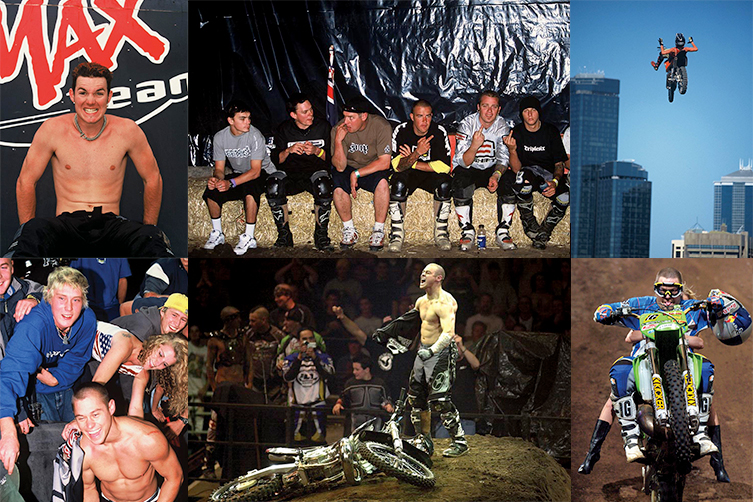
Aspiring journalist Ben Dillaway jumped on the 2002 tour. “I was 17 and still in Year 12 when I covered my first Crusty tour and had to get a fake ID to do it,” he recalls. Dillaway earned the trust of the riders and penned stories that few other journalists were able to get to, but it was the ones he didn’t pen that he will never forget: “I remember my first Crusty afterparty. It was on the rooftop of some cool place in Brisbane. I was just standing there and this guy had fallen and smacked into the cement. He was unconscious before he had even hit the ground. Turns out Mad Mike Jones had hit him,” remembers Dillaway. “I’m pretty sure Mike broke the guy’s jaw and had to come back to Australia to face charges for it.” Dillaway is now the chief police reporter for the Gold Coast Bulletin newspaper and is a long-time contributor for Freerider MX. He was booted off the 2007 Capital City tour for unruly behaviour.
![]()
THE FLIP ERA
![]()
After Carey Hart’s first Backflip it took several years for the rotation to be mastered, but on July 2, 2002, Mike Metzger did just that. Across the other side of the world, three little-known “weekend warriors” decided to have a crack at it about the same time. “I heard through a mate that this guy was going to do a Backflip this weekend,” recalls Mark Petersen, a Freerider MX photographer at the time. “I thought, ‘What? A Backflip?’ No Aussie had ever done a Backflip at this stage – so I headed off to a place just out of Melbourne and there were three guys with old bikes and this one young fella called Rob Felli said he was going to go for it. So I set myself up and sure enough he did it on this homemade ramp that you wouldn’t jump off with a BMX.”
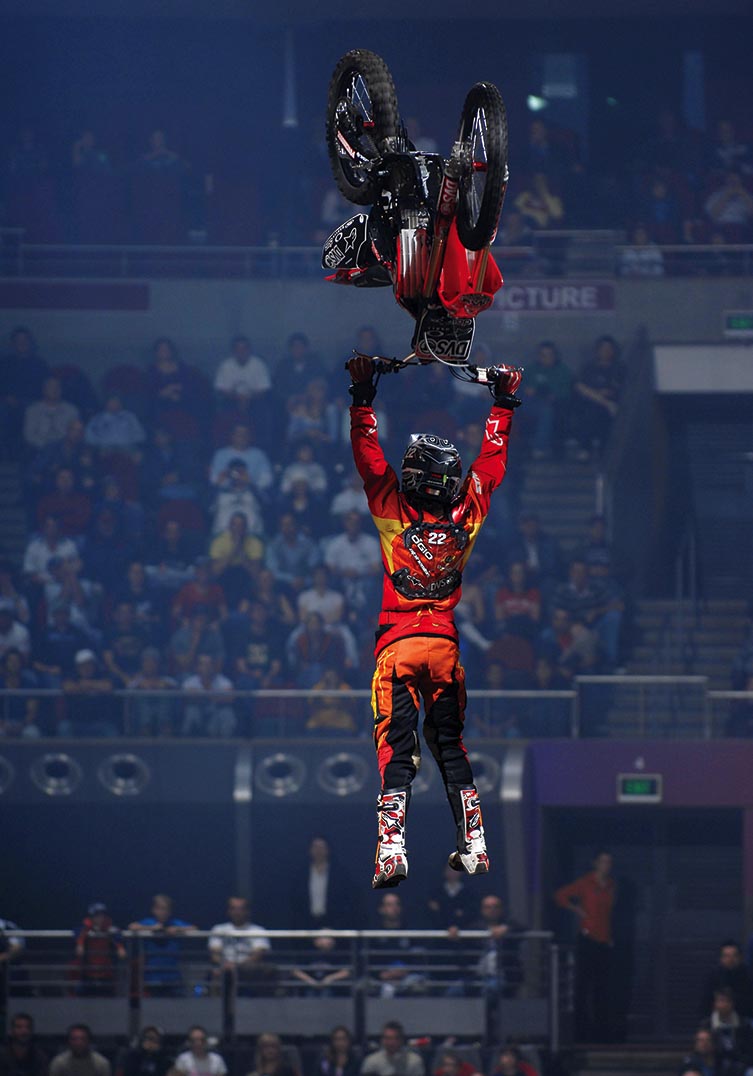
The iconic image of the 2008 Crusty Tour: Bilko’s Jackhammer.
Further north, at Jono Porter’s place in Gladstone, Kain Saul and Porter had planned the day they would flip. “We were at Gladstone behind Jono’s dad’s workshop where he had a big downramp the week after Rob Felli had done his,” remembers Saul. “I wasn’t too worried about it, but Jono was up all night and couldn’t sleep because he was just so nervous. We got up and went at it and Jono hit the ramp, pulled back and did it perfect first time. He did a whole shitload of them perfectly. Then I went straight up and hit the ramp and didn’t even get quarter of the way around, but within seven goes I landed it and rode out. We were so pumped up after that.” Once Porter had the Backflip on tap, Aussie freestylers knew they had to learn the trick or fade into obscurity. The floodgates were open, but the torrent was far stronger in America allowing the US riders to widen the gap in the inverted stakes – mostly because of their uptake of foam pits. “I think the advent of the foam pit was probably the single biggest thing that saved FMX,” claims Holtzy. Aussie riders soon cottoned on and foam pits became a regular feature in most compounds at the same rate as the new tricks that were being mastered in them.
![]()
CLOSING THE GAP
![]()
Americans dominated freestyle motocross in those early years and were always one or two steps ahead, but that all changed in 2002 when Dayne Kinnaird was invited to compete in the US X Games. He took with him the combo – and the American riders knew he would be a real contender. “I think the combos are where I really made my name,” laughed Kinnaird. “They just came about when I realised I had enough time to throw another trick in.” Kinnaird went on to make history by becoming the first Australian to medal at the US X Games when he won silver at the 2003 Winter X Games. “I was a pretty hard critic of myself and I have never been proud of that medal,” says Kinnaird. “Everyone brings up that silver medal and says, ‘That must be a highlight’, but that medal is under the bed at my old man’s house just collecting dust – I don’t hang it on the wall or even look at it. I see that trophy as being the first loser – that’s just how I look at things. I was brought up to win.” Kinnaird is now a qualified electrician and works in his father’s company in Newcastle.
![]()
ADVANCING TIDE
![]()
By 2006, Australia’s elite riders had caught up to the US riders again. Bilko won a bronze medal at the X Games and had his sights set on gold. “It was incredible – coming in as an unknown rider in my first contest and pulling a trick that blew everyone away and earning bronze was amazing,” Bilko explains. “I felt I could have gotten the gold a little earlier, but injuries held that up.” Robbie Maddison believed Aussie success was only a matter of time: “The reason we’re so good is that there is not much of a scene in Australia competitionwise, so we see the world stage as being the place to go.
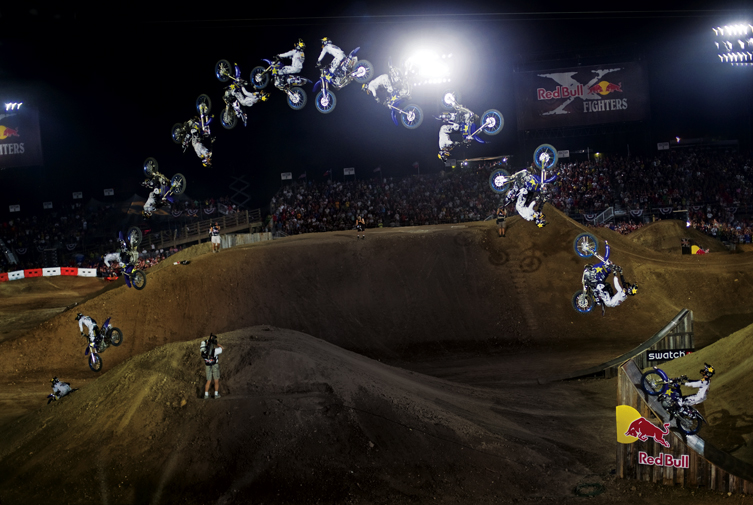
Cam Sinclair’s first attempt at the Double Backflip in Spain was the first time he had jumped a two-stroke to dirt.
We see the top guys and that is the level we aim to get to,” he asserts. “Now Sincs is doing Double Backflips, Bilko’s got the 360 down pat and Levi is the rubberman and bringing his own style.” “We are on par with the rest of the world,” Bilko adds, “and, at some points, we are on top.” Between Bilko, Maddo and Cam Sinclair – who all compete at the X Games, X-Fighters and the Dew Tour – they’ve taken their fair share of podiums in the past four years. “That’s pretty good, considering the sport was USA-dominated for about 10 years,” says Bilko. “Australia is the new USA of FMX,” claims Makker. “At Mexico X-Fighters, there were four Anzacs competing – Bilko, Maddo, Sincs, Levi – while over in Europe, Robbie Adelberg smashed the best Euros to win a round of the FIM World FMX Championships. The scene here is blowing up, and there’s a lot more to follow.” Leith Holtzman agrees: “Bilko and Sincs are amazing. We are blessed with our current crop of riders. Throw in Mini, Maddo, Adelberg, Sheehan, Levi Sherwood, Nick Franklin and it’s amazing how many good riders have come from Oz or NZ.” In 2009, Bilko became the first nonAmerican to win US X Games gold. “It was a very proud moment for me and my parents, who have supported me so much I can’t even start to thank them,” explains Bilko. “Most riders just hold their medal up at the awards ceremony but I made sure I had the medal in one hand and the Aussie flag in the other the whole time … true blue, mate!” Bilko says he earned about $300,000 last year, but expects the X Games gold will add significantly to that sum in the years to come.
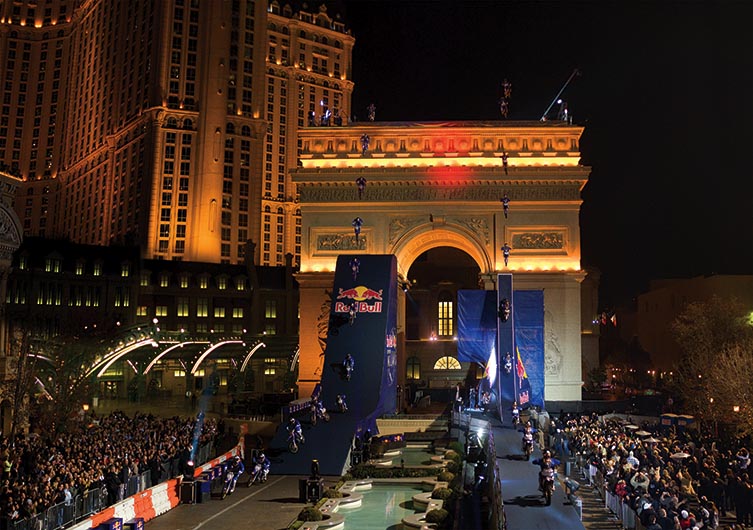
Robbie Maddison saw in 2009 by jumping onto the roof of the Arc de Triomphe in Paris Las Vegas, then freefalling onto another ramp
On a slightly different path to Bilko, Robbie Maddison has beamed Australian FMX into living rooms throughout the world with his stunning records and jumps. “World records, international wins, stories on 60 Minutes, and he has Backflipped over the Thames River … Maddo has taken Australian FMX to the highest level,” says Holtzy. “He is a special person and a true Aussie hero.” Maddison is far from finished and said an X Games gold medal was on his list: “I have heaps of things on the go,” he told Transmoto. “It’s all exciting stuff – there are a lot of things that have never been done, before I do the ultimate jump: the Grand Canyon. I have a dream to do it and I think I know what it will take to do it. I don’t really want to talk about that because people might think I’m crazy,” he laughs.
![]()
WHERE TO FROM HERE?
![]()
Carefully watching the progression has been Gary Reid of ShowTime FMX. “I remember commentating my first FMX comp – it was X Games in Melbourne and Carey Hart was there. I was talking to Jono Porter and remember saying that the Flip will never become a consistent trick that we’ll see all the time,” he recalls. “One-and-a-half years later I was commentating another show and Jono performed the first Backflip in a comp in Australia. A couple of years after that Robbie Marshall performed the first Backflip in a ShowTime FMX show. I was at X Games USA in 2006 standing with Robbie Maddison and witnessed the first ever Double Backflip by Travis Pastrana. I turned to Robbie and said, ‘We won’t see that too often’. Then, three years later, I commentated Cam Sinclair’s Double Backflips every night on the Crusty Tour. It is because of this that I don’t comment anymore – I have no idea what is next for FMX!” Reid is certainly not the only one to admit defeat in the visionary stakes. Many expert commentators of the sport had wondered when the limit would be reached.
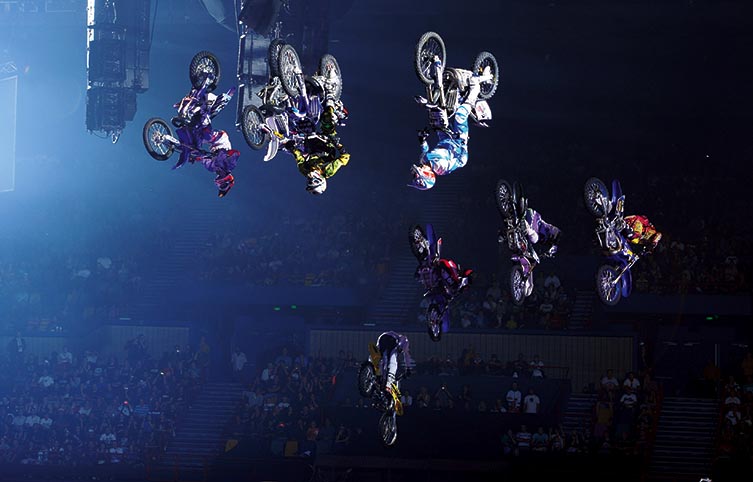
Makker wrote an editorial in Freerider MX at the end of 2008: “I questioned whether we’d hit the limit of what was possible,” he tells Transmoto. “But then, within a three-week period, Ronnie Renner booted 59.2ft out of a quarter-pipe on the Santa Monica Pier, Swedish lad Fredrik Johansson landed a 540-Flair out of a dirt quarter-pipe at the Madrid X-Fighters, then Jim DeChamp landed the Frontflip to dirt for the first time, and Jeremy Lusk (Backflip Double Grab Hart) and Kyle Loza (Electric Doom) landed never-before-attempted tricks at X Games! After that, I vowed never again to doubt this sport’s progression.” Maddison believes the next crop of riders is already emerging in Australasia and he claims that Levi Sherwood’s X-Fighters win (on debut) was no fluke. “Levi Sherwood is a testament to that depth,” says Maddison. “There are a lot of kids out there who are pushing the envelope in Australia – underground kids who have Backflip Kiss of Deaths that are just huge, and the future hinges on them.” Bilko sees no respite to the advancing tide of FMX: “It’s just going to keep progressing trick-wise. The trouble is the progression is exceeding the level of safety by about 10-to-one!”
![]()
LANDMARK MOMENTS THAT SHAPED FMX DOWN UNDER
![]()
Circa 1987: The Expression Sessions – Australian SX Masters promoter, Phil Christensen decides to capture the aerial talents of the riders by showcasing their tricks in an Expression Session. “Big names of the time included Craig Dack with his classic No Hander,” recalls Danny Ham who was also in that mix. “There was also Phil Sargent with his No Legged Whip, Joel Elliot with his Whips and Heelclickers, and who can forget Troy Dorron with the Dozza Lookback Whip.”
1998: The First Planet X Games – Under the watchful eye of judge Seth Enslow, Troy Carroll wins Australia’s first freestyle motocross competition with big Double Can Cans and “Shin Scrapers – they were nearly Cordovas,” explains Robbie Marshall. Held at Southport on the Gold Coast, the competition attracted Australia’s best: Robbie Marshall, Adam Cini, Leigh Harriman, Chris Thomson, Takashi Katsuya, Troy Dorron, Troy Carroll and Andrew McFarlane.
1999: All Crusted Out Tour – Perth Crusty touches down in Aussie for the first time and the fans steal the show, creating havoc and setting a car on fire. The organiser, Wayne McNabb, instantly knew he had struck gold. The Crusty Demons couldn’t believe such a lawless place actually existed. It was a match made in freestyle anarchy. The Crusty Tours went on to become “the most successful touring group in Australia, bar none”, according to Simon Makker.
Late 1999: Issue 1 of Freerider MX Magazine – A straggly Michael Gilbert knocks on the door of Morrison Media in Burleigh Heads to pitch the idea of a freestyle motocross magazine. “I was intrigued … I was already aware of FMX as I had friends who were involved, so I thought it was hugely exciting, and Gilly can tell a good story,” publisher Peter Morrison recalls. Freerider MX has become the world’s longest-standing FMX mag.
2000: Carey Hart Lands A Backflip – Hart’s Backflip at the Gravity Games in 2000 had nothing to do with Australia, but it changed the sport of FMX throughout the world and put a lump in the throat of any self-respecting FMX rider. Hart compressed vertebrae in the process and it would take him until the 2001 X Games to muster the courage to attempt another. But he’d opened a Pandora’s box.
2000: Melbourne Planet X Games – Held at Docklands, many believe this was the true birth of Australian freestyle. Carey Hart wore a t-shirt with “No Backflips!” handwritten on it, while Dan Hall’s ran a VB singlet for his runs. But both were left stunned by Newcastle rider Dayne Kinnaird, Kiwi Rhys Dulieu and Melbourne’s own Luke Urek. This became the first glimpse the world got of the new generation of Australasian FMX riders.
2002: Dayne Kinnaird Breaks Into US X Games – Kinnaird didn’t just turn up at the US X Games in Philadelphia and have a crack at the holy grail of FMX. He arrived with something that few had seen before: the combo! Catwalks to Heelclickers were his daily bread and the US riders knew they had a contender on their hands. Kinnaird won a silver medal at the 2003 Winter X Games. Not only did it make the Americans take notice of what was going on down here, but he broke new ground for all the Aussie riders who thought getting to the States was in the too-hard basket.
2002: Victorian Robert Felli Lands Australia’s First Backflip – On July 2, 2002, Mike Metzger, landed a ramp to dirt Backflip and began to master the rotation. About the same time, but on the other side of the world, a little-known Victorian rider and a bunch of his mates dragged a photographer to a shonky ramp to dirt, hay and straw lander just outside Melbourne where Rob Felli made history. He also set off a chain of events that would culminate, within days, with Jono Porter and then Kain Saul mastering the Backflip.
NYE, 2008: Maddo Goes Supersize – Kiama freestyler Robbie Maddison opens the taps and propels himself 98.34m through the Las Vegas sky and into the world record books. A few months later he smashes that record and breaks the 100m barrier with a 107.29m jump at Calder Park Raceway. At the end of ’08, he returns to Vegas and jumps onto the top of the 29m-high Arc de Triomphe at Paris Las Vegas and then freefalls from its roof to another ramp. On July 13, 2009, he jumped the Tower Bridge above the Thames after the iconic bridge had been raised – performing a No-Handed Backflip en route. In April this year, he jumped 85m across the Corinth Canal in Greece – the man is a genius!
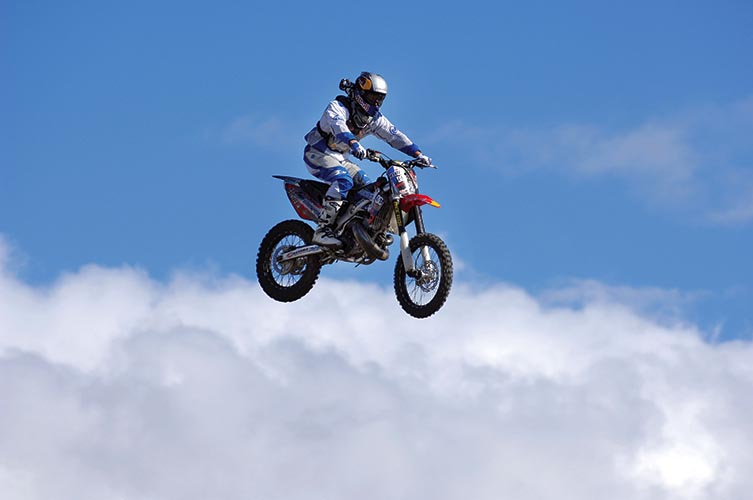
2008: Cam Sinclair’s Double Backflips – Aussie Cam Sinclair stepped into a space occupied by few others at a no-name Spanish event in December, 2008, when he performed his first Double Backflip. That same jump was also the very first time Cam had hit an FMX ramp to dirt on a two-stroke machine. He went on to perfect the Double Backflip, but in Madrid last July his rotation wasn’t complete and the gnarly crash nearly killed him. Sincs’ crash, near death, then recovery and back to Double Backflipping just nine months later is one of the most inspirational stories in the sport. It’s gotta rate as one of Australia’s greatest sporting comebacks.
2009: Levi Sherwood’s X-Fighters Win – The 17-year-old “Rubber Kid” cut his teeth as a young Crusty rider, but he shot to real stardom when he won the Red Bull X-Fighters event in Mexico last year in what was his first big international event. The talented Kiwi rode the first four-stroke to be seen in the competition and became the youngest rider to ever win an X-Fighters event. Four of the 12 or so X-Fighters riders are now from Australia or New Zealand.
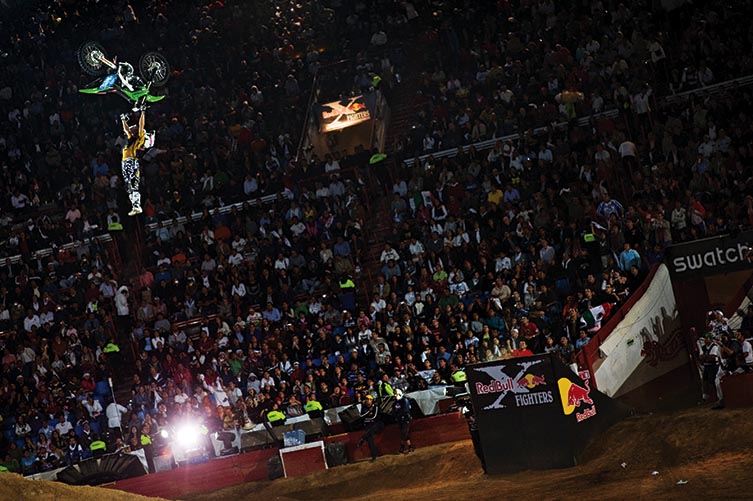
2009: Bilko’s X Games Gold – It was a long time coming for an Aussie to sink his teeth into an X Games gold medal, but Blake Williams finally broke through the dubious judging sheets to emerge victorious in Los Angeles last year. Defeating Nate Adams in the final, Bilko’s win put the previous night’s Best Trick judging blunder behind him (he should have won gold – even Kyle Loza, who did collect gold, tried to swap medals later), but Bilko had etched a new chapter in the Australian freestyle story.
![]()
TRANSMOTO’S FMXPERTS PANEL
![]()
TROY CARROLL
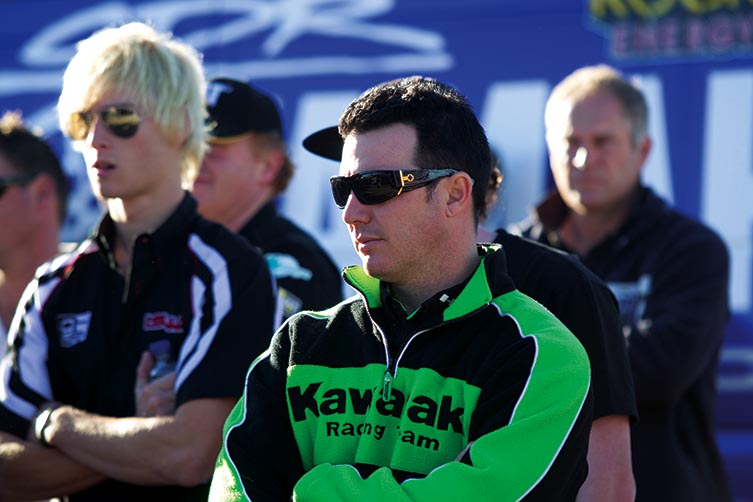
Age: 30
Hometown: Toowoomba, Qld
Involved in FMX since: 1998
Current role in the sport: Team Manager, Kawasaki Racing Team.
Most memorable FMX moment: Winning X Games in 1998 on the Gold Coast.
SIMON MAKKER
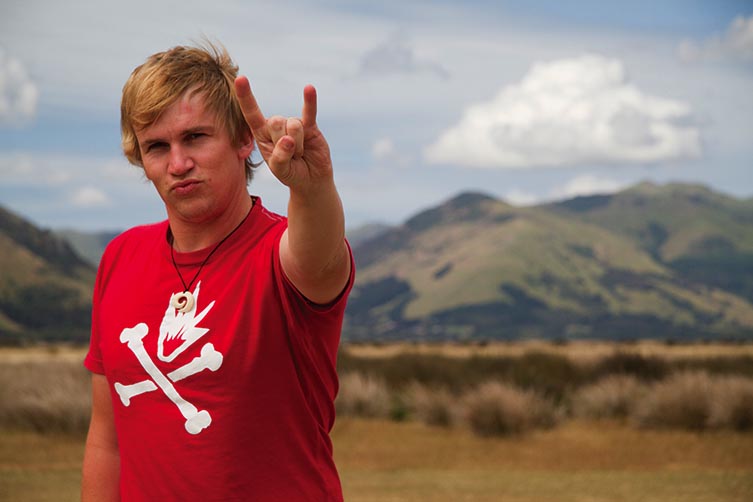
Age: 29
Hometown: Morrinsville, NZ
Involved in FMX since: 1999
Current role in the sport: Editor, Freerider MX Magazine.
Most memorable FMX moment: Standing on the sidelines when Bilko won the Freestyle gold medal at the 2009 X Games at Home Depot Centre, Los Angeles, California.
ROBBIE MADDISON
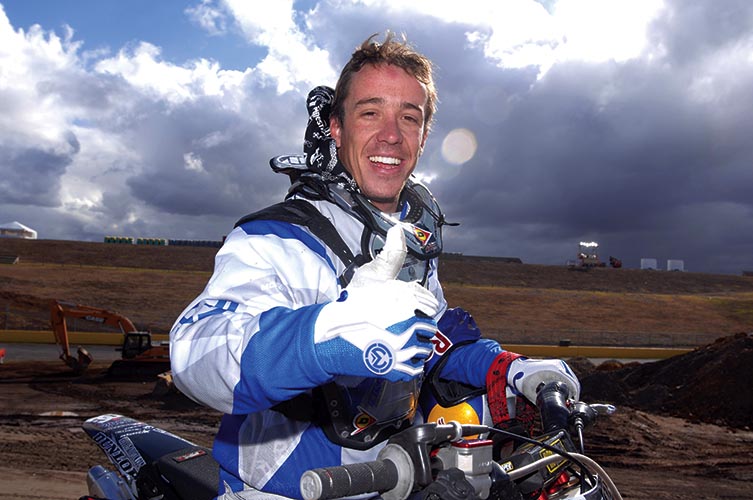
Age: 28
Hometown: Kiama, NSW, & Temecula, SoCal
Involved in FMX since: 2001
Current role in the sport: Professional FMXer.
Most memorable FMX moment: Sitting at the bottom of the Arc de Triomphe and preparing to jump on to the top of the building and then off it again.
KAIN SAUL
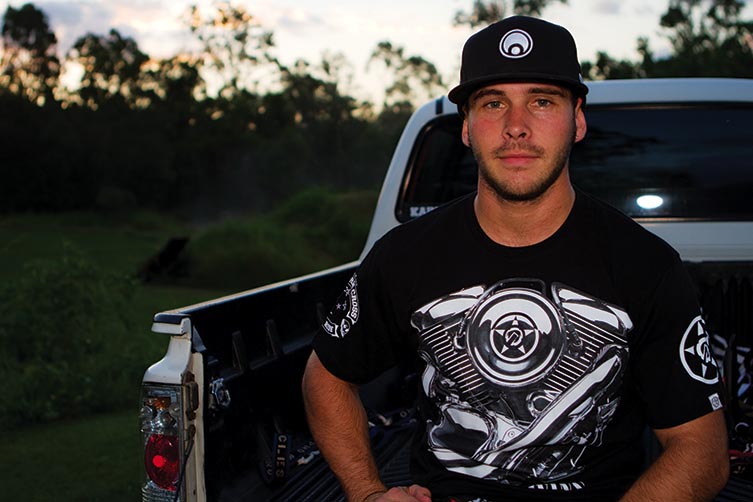
Age: 25
Hometown: Gladstone, Qld
Involved in FMX since: 2002
Current role in the sport: Professional FMXer.
Most memorable FMX moment: Last year when I landed the first ever Harley Davidson Backflip at Cam Sinclair’s compound in Melbourne. It weighs 280kg and is a crazy machine to ride.
BLAKE “BILKO” WILLIAMS
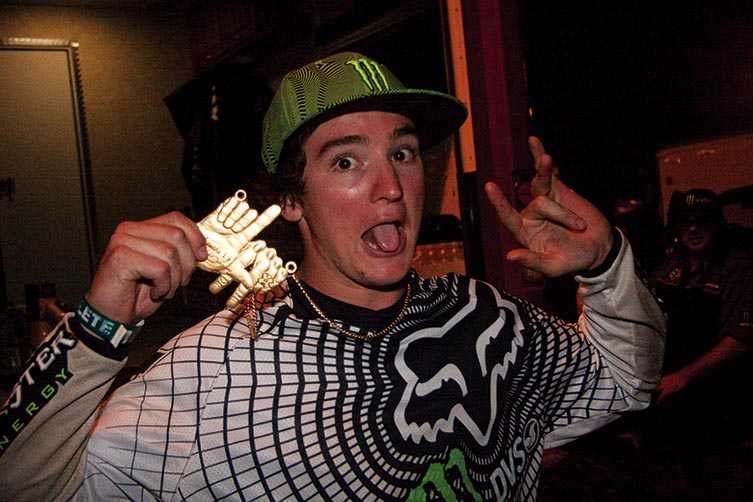
Age: 25
Hometown: Baxter Australia & Murrieta, SoCal
Involved in FMX since: 2003
Current role in the sport: Professional FMXer.
Most memorable FMX moment: Winning Freestyle Gold at X Games 15 and being the first non-American to do so.
LEITH “HOLTZY” HOLTZMAN
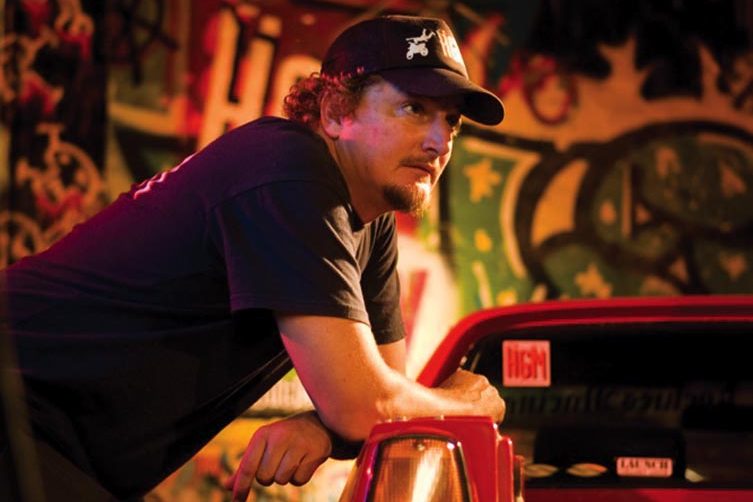
Age: Depends on who I’m chatting up
Hometown: Margaret River, WA
Involved in FMX since: 1999
Current role in the sport: Creator and owner of Homegrown Maniacs DVD and TV series, senior photojournalist for Freerider MX, event commentator and organiser.
Most memorable FMX moment: It’s hard to pick one defining moment. Maybe seeing Maddo on 60 Minutes – that showed how far FMX had come in Australia.
STUART GUNDRY
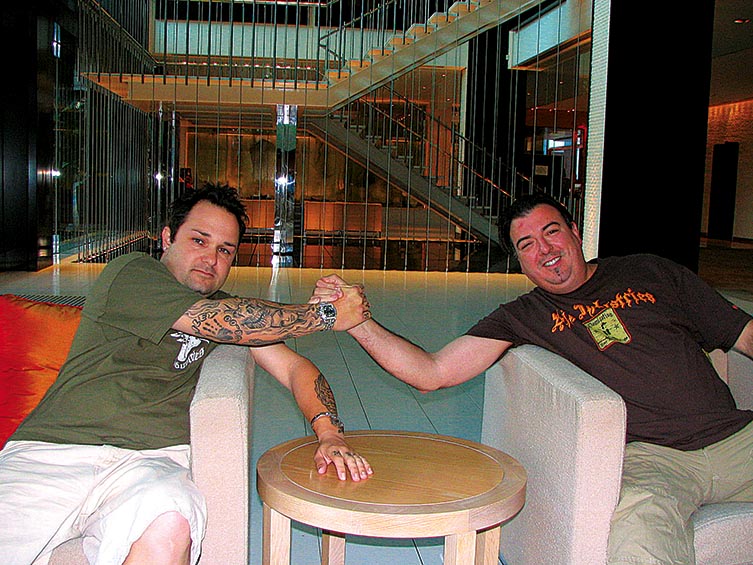
Age: 45
Hometown: Port Melbourne, Vic
Involved in FMX since: 1995
Current role in the sport: Owner of Platypus Distribution, which distributes FMX lifestyle apparel and includes Skin Industries, SiksPac, Valleyside, Moto Grip and VisuWalls.
Most memorable FMX moment: When Carey Hart competed in the Melbourne X Games in 2000 – that was pretty gnarly – a few months after his first Backflip.
GRANT “GOBA” O’BRIEN
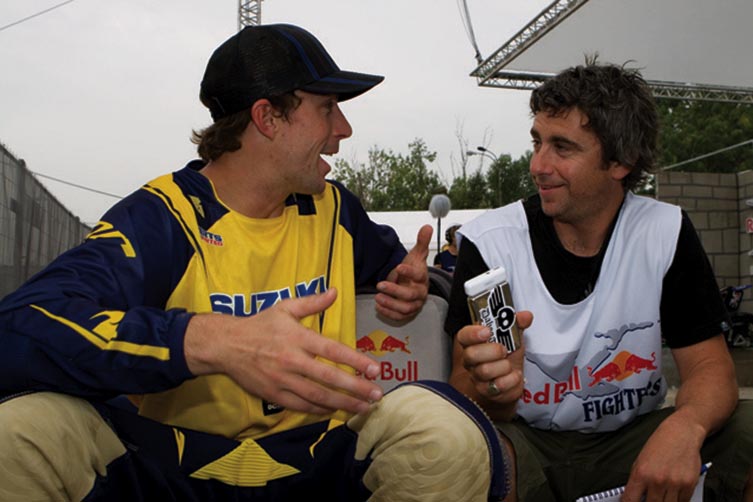
Age: 41
Hometown: Lillian Rock, NSW
Involved in FMX since: 1999
Current role in the sport: Photojournalist for Freerider MX magazine, Red Bull X-Fighters 2010 judge, contributor to ESPN Action Sports America.
Most memorable FMX moment: Watching Levi Sherwood win his first X-Fighters comp in Mexico City was pretty special. And seeing Maddo successfully make his Arc De Triomphe jump in Vegas last year was magic.
Related Content

CRUSTY DEMONS TOUR: IT’S BACK!
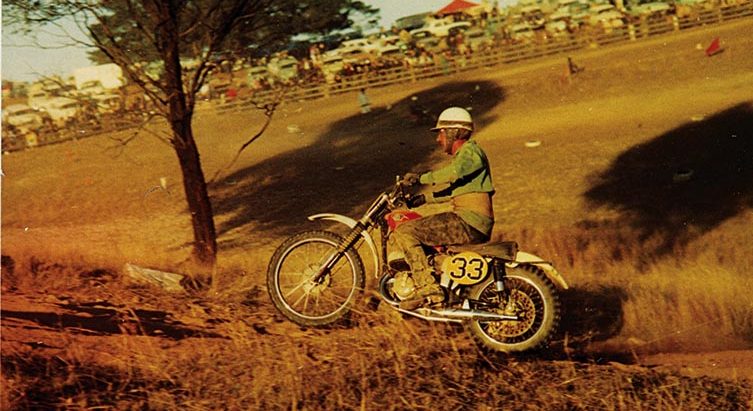
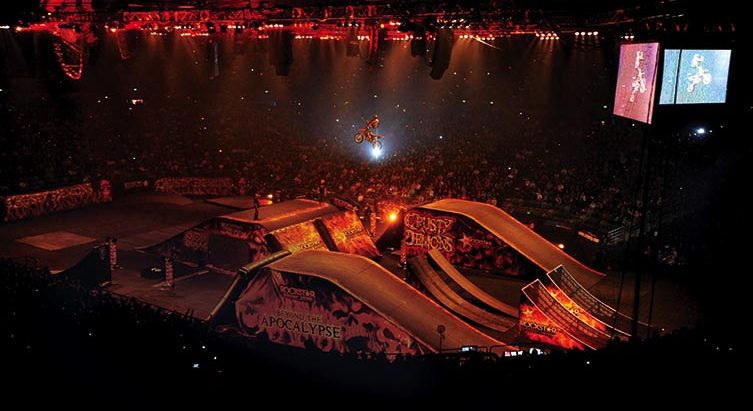







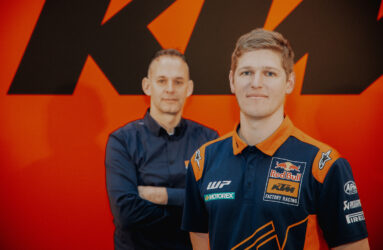
Be the first to comment...